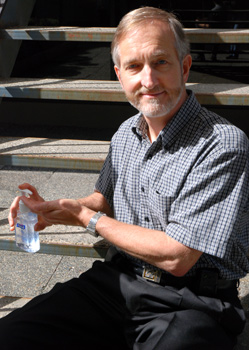Fraser Health predicts and prepares for worst-case flu scenario
January 12, 2010 by Sarah Jackson

Dr. Roland Guasparini, chief medical health officer for Fraser Health, models the use of hand sanitizer as protection against H1N1 contraction. (Sarah Jackson photo)
After months of monitoring the southern hemisphere’s H1N1 cases, Fraser Health has determined 40 per cent of the world’s population will catch H1N1 before next April.
The number is twice the yearly 20 per cent seasonal flue infection rate, according to Dr. Roland Guasparini, Fraser Health’s chief medical health officer.
“The vast majority are going to have a mild, self-limiting illness,” Guasparini said. “[But] the flu’s not really mild. You will feel like you get hit with a truck.”
Fraser Health based its estimate on the number of cases that have been reported in the southern hemisphere. As winter and the flu season comes to an end there, the infection rate offers a glimpse into what residents of the northern hemisphere should expect.
Guasparini said Fraser Health has been planning for a severe pandemic for many years, expecting it to surface at any time. The summer arrival of the H1N1 flu suggests that the virus will peak early, over the next eight to 12 weeks, and taper off by December.
The health unit has spent most of its time planning for a worst-case scenario including 200 intensive-care patients, more than Fraser Health facilities can currently house.
To prepare, it has planned alternative treatment sites, purchased additional ventilators and decided how to staff additional health care locations.
“But we’re not going to see that worst-case scenario,” said Guasparini. “We’re expecting, based on the southern hemisphere, that we’ll be able to manage the hospital cases as usual.”
H1N1 is a contagious disease, he explained, so “the attack rate will be the same regardless of the severity of the symptoms.†A mild disease could, however, allow H1N1 to spread more widely than expected if infected people don’t remain home until they recover.
Current concern is for the elderly, children, pregnant women and those with chronic respiratory and cardiac conditions. Those who fall into these categories are at a high risk for severe illness until they receive the H1N1 vaccination, which will not be available until November.
“We’re hoping . . . we just have a seasonal flu year, but the nice thing about all the media attention is that it’s just brought attention to safety conditions,†said Guasparini.
The message about hand-washing, coughing into a shirt sleeve and staying home when sick “has hit home in a big way.â€
He said the media is doing a great job of accurately presenting H1N1 facts. Public-health workers are dealing with the additional strain of responding to patients’ concerns, but the attention devoted to understanding the threats and safety procedures is a new and welcome phenomena.
During previous pandemics, the methods of communication were far more limited.
Guasparini said the international attention and response is a testimony to the system health officials have for monitoring and responding to infectious diseases.
“People are not scared, they just kinda focused their attention.â€
Don MacLachlan, former managing editor at the Province and former director of public relations for Fraser Health, agreed that media has “been doing a very responsible job.â€
MacLachlan said the public perceives H1N1 as a problem, and its status as a pandemic means it is, so the media is rightly informing people about it.
A number of rumours have cropped up since H1N1 first appeared, leaving some people hesitant to trust media coverage. Bulletins have been issued debunking beliefs that H1N1 can be contracted by eating pork, that entire villages in Asia were being wiped out and that the coverage is only hype. But the myths aren’t from the mainstream media, said MacLachlan.
“People aren’t reading or listening to traditional media news. They get news from Facebook, Twitter or MySpace and they treat that as the definitive truth.â€
The media attention has pushed some towards fear or skepticism about the reality of the threat. MacLachlan attributed any “exaggerated state of concern or panic†to individuals who are receiving the media’s messages. He added that “people are hearing and reacting responsibly to responsible messages.â€



Comments
Feel free to leave a comment...
For details on how we handle comments, select "Our Comment Policy" from the "About" drop-down menu at the top of the page.
Note: All comments are moderated and must be approved before they are published.